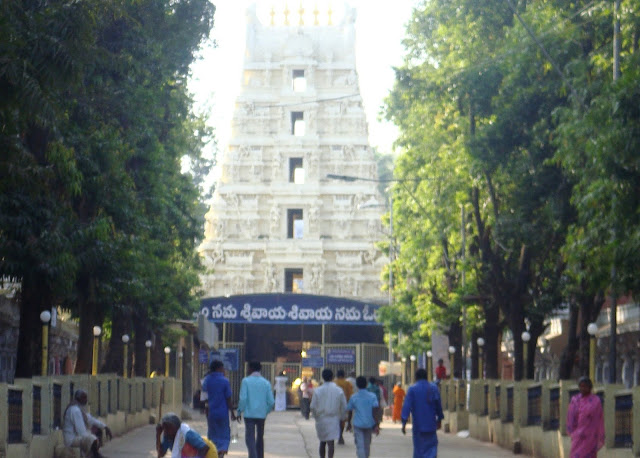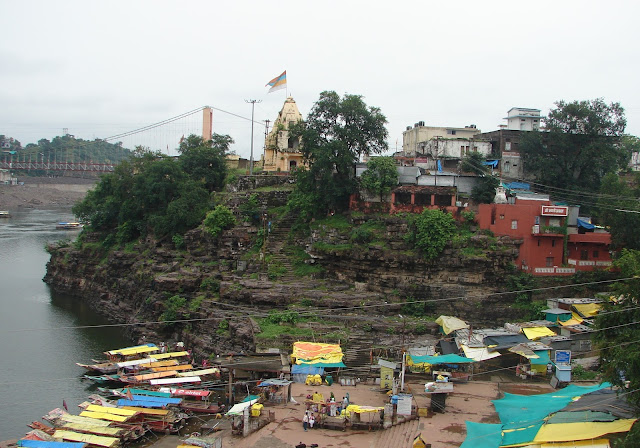My interpretation of Khajuraho in brush and paint  |
Location of Khajuraho
|
THE SENSUOUS TO THE SUBLIME
Khajuraho, possibly a derivation from Khajurvahak (bearer of the date palm - Khajur (date palm) vahak (bearer) is a small town in North Madhya Pradesh. It was built around 950 AD by the powerful Chandela rulers of Bundelkhand, the descendants of the Moon as legends speak. The story of Khajuraho is well presented in the evening light and sound shows held in the western temple complex. As the legend goes, the Casanova Moon God Chandra, lost his heart to the beautiful Hemavati, the daughter of a high priest of Benaras. One day when Hemavati was bathing in a river, enamored Chandra, unable to resist her exquisiteness, descended from the sky, disguised as a handsome prince, and seduced her. After a night of passionate love, Moon left with a promise to her, that she would bear their son, who would grow up to become one of the most powerful kings of his times and establish a dynasty of equally powerful kings. As blessed, Hemavati bore Chandra's son Chandravarman who became the founder of the Chandela dynasty. Khajuraho was their first capital before shifting to Mahoba. It is said that the temples were built by Chadravarman to atone for his illegitimacy. While that's the more romantic legend, the historically documented version suggests Nannuk, a chieftain of a small Chandel clan as the founder of the Chandela dynasty. Probably the legend was later created to give a more divine lineage to the Chandelas thus legitimizing their Chandravanshi (lunar lineage) status.
 |
| Chitragupta Temple, as seen from the Jagadamba Temple (western group) |
Today Khajuraho is synonymous with the art of Kamasutra (treatise on love). Ironically, Vatsayan's work on the subject written in the 3rd century had no particular relation with Khajuraho. How and when this association became an identity is difficult to trace. But of course, marketing tourism works wonders. Eroticism definitely has its way of titillating audiences and inviting them to the remotest of places. Nevertheless, the allure is unmistakable.
 |
| Erotic art in Khajuraho temples |
The sculptures showcase carnal expressions of every possible nature. The voluptuous, graceful figurines etched to the finest details exude captivating sensuality. One definitely cannot ignore the erotic splendor. As ribald as it may sound, the panels depict explicit orgies, elaborate coitus, masturbation, homosexuality, and even bestiality. However, it is interesting to note, that though iconic for its erotic art, eroticism actually covers a very small part of the Khajuraho temples. And if one really dives deeper into the philosophy, this eroticism begins to appear more mystical and symbolic.
A curious question often arises, Why were these sculptures sculpted in temple precincts, especially in India where sex is considered extremely private and public expression of anything even remotely related is a taboo. There are various theories to answer this query. For that, we might need to travel back to the times when these temples were built and dig a little deeper into Hindu philosophy.
HINDU PHILOSOPHY
Core Hindu philosophy says, that every Purush (human/soul) born must work towards attaining good karma (action) through the four purusharthas (purpose of a human)/goals: Dharma (righteousness), Artha (wealth), Kama (pleasure) and Moksha (liberation). Thus, asserting kama is an essential aspect of human life. Only when in conflict, dharma must take precedence. Hinduism was more liberal and more scientific in its original principles than it is today under the influence of the political play of the so-called religion pandits. it's interesting again to note that in the 10th century, even homosexuality was more in acceptance than it is today.
 |
| Maslow's hierarchy of needs |
In fact, if you really look at Maslow's hierarchy of needs, the most fundamental levels of needs are at the bottom and the need for self-actualization is at the top which precisely is the temple concept. Every religious philosophy originates from scientific roots. Self-actualization is nothing but the ultimate step to attaining moksha or nirvana, the absolute liberation of the soul, which is the key to reaching god. I believe finding oneself is reaching god. 'Aham brahmasmi', I am God, an ancient Hindu philosophy that suggests that God resides within us.
Thus, the eroticism depicted is only a part of the various actions of a human being in a lifetime, like hunting, artistry, fighting, and worshipping, which fulfills the four purusharthas, kama inclusive. The men depicted in the sculptures are supposed, the everyday man, the priests, and the royalties. The women are supposedly the everyday women, apsaras, sura sundaris, courtesans, devadasis, yoginis, and court dancers. In ancient times, Indian men and women draped in various forms of saree or long cloth had long hair and were heavily bejeweled. The sculptures depict what they wore and dressed like in those times. The drapes are vividly detailed, and every fold and every crease is defined meticulously to demonstrate the remarkable finesse of the sculptors and artisans.
It is said that tantra was on the rise during ancient times (it is prevalent even today but in secrecy and has occult connotations - the Aghori sadhus and tantric practitioners are supposed to perform these spine-chilling rituals). The Chandelas like many others were also assumed to be great patrons of the tantric cult (as told by local guides). Tantric rituals were performed not only for personal liberation but also to augment the power of the kingdom. There were special yoginis and priests who performed these tantric rituals and maithuna (sacred sexual union) was a predominant part of these rituals. Tantric philosophy suggests that sexual energy can be channeled to transcend into spiritual liberation or unification with Shiva or the supreme force. The kundalini concept another aspect of tantric philosophy suggests a human has 7 chakras (energy points) and there is a coiled serpent in the lowest point of the spine called kundalini (the driving force). To attain moksha or to experience the ultimate mystical, spiritual bliss, this serpent must be awakened through the release of the latent energies in the 7 chakras, which is possible through various rituals, yoga, meditation, or maithuna. (I am not well versed with tantric or kundalini philosophies, so there might be errors in my understanding, and will therefore avoid delving into this subject in greater detail)
 The Chausat 64 yogini temple was supposedly the abode of these temple yoginis. A particular sculpture has often been talked about and mentioned by the local guides, a woman undressing her transparent drape to ward off a scorpion climbing her left leg. Presumably, the woman is a yogini and the bearer of scorpions. Scorpions have from times immemorial symbolized human sexuality in various ancient cultures and have been reared by seductive yoginis for tantric purposes. This particular mythology suggests a second theory for the name Khajuraho. A scorpion was called Kharjura and Kharjura vahak is a scorpion bearer.
The Chausat 64 yogini temple was supposedly the abode of these temple yoginis. A particular sculpture has often been talked about and mentioned by the local guides, a woman undressing her transparent drape to ward off a scorpion climbing her left leg. Presumably, the woman is a yogini and the bearer of scorpions. Scorpions have from times immemorial symbolized human sexuality in various ancient cultures and have been reared by seductive yoginis for tantric purposes. This particular mythology suggests a second theory for the name Khajuraho. A scorpion was called Kharjura and Kharjura vahak is a scorpion bearer.Why that level of eroticism?
I think every human at some point has fantasized the wildest. The idea is to release that extreme form of latent energy associated with craving and desire and then be completely devoid of the want for more. The goal is to arrive at that saturated state, the extreme peak. Once that state is attained, one is ready to move to the next level, where one is more in control of self. As depicted by the inner chambers of the temples the sculptures are more austere, pure, calm, depicted as singular entities, and free from any worldly expressions. A person who finds peace in this nothingness is then eligible to move to the innermost sanctum, the garbhagriha, which has stark walls, no openings (except the entrance door), and the idol. It is that absolute point where one is alone with self or god or the idol, the manifestation of God.
Therefore the concept of a temple is more a process of reaching moksha or unification with the supreme power leaving behind the worldly desires in steps, the basest to the supreme - the sensuous to the sublime.
 |
| Gods and Goddesses, sculpted on the western group of temples. Lord Ganesha (top) and Goddess Lakshmi (bottom) can be seen on the right |
The temples are built of pink river sandstone with intricate and detailed carvings. It is said it took 25 years to complete each temple. It is one of the few historical sites where Jain and Hindu architecture makes a perfect blend and undeniably, one of the best. Erotic art or not, one can simply admire the skilled craftsmanship and the elaborate grandeur of these monumental edifices.
 |
| Jain and Hindu Architecture complement each other. Shantinath Temple on the left, Parshavnath Temple on the right, and a part of Adinath Temple seen behind Parshavnath Temple (eastern group) |
Apart from the temples, Khajuraho is also famous for the Dance festival held every year around Feb/March. With the backdrop of these magnificent temples, the festival is beyond doubt spectacular. A must-visit if you are an ardent fan of Indian classical dance and music.
LOCATION
Country: India
State: Madhya Pradesh
HOW TO REACH
Khajuraho has an airport, railway station, and bus service. There is a 6-day-a-week (off on Wednesdays) direct train from New Delhi as well, which runs from Hazrat Nizamuddin station. Reaching the train that November was quite a Dilwale Dulhaniya le Jayenge moment for me. Nope, no Shahrukh held out his hand, unfortunately:( I helped myself up :P. The journey takes roughly 8 hrs. At the railway station, one can find taxis and auto-rickshaws to reach the town center.
BEST TIME TO VISIT
Anytime is a good time to visit Khajuraho, though summers are extremely hot and winters are mild as mentioned above, if you love classical dance and music, it would be worthwhile to visit this place during the dance festival held every year in February/March.
WEATHER and WHAT TO WEAR
It's mostly warm to hot in Khajuraho. Light cotton goes best. During winter, early mornings and evenings get colder and it's advisable to carry a jacket.
WHERE TO STAY and WHAT TO EAT
 |
| Light and Sound Show at the Kandariya Mahadev temple complex |
Hotels here range from luxurious 5-stars to inexpensive bed and breakfasts. During the dance festival, it gets very busy there and it is best to pre-book the hotels but otherwise, I would guess, rooms are available in most hotels. One can go there, see the rooms and then decide on the hotel (and am the kind who likes to keep an open itinerary, so that plans can be kept flexible!!).
Would make a special mention of a restaurant Bella Italiano run by an Italian lady. Both the Indian and Italian dishes there were quite good. It was so yummilicious (PS: don't try to find this word in the dictionary) I had a double dinner of plain ajwain daal and bhindi masala.
ACTIVITIES
Architectural excursions to the temple sites. One day is enough to cover all the temples but I would suggest giving a day to the Western main temple complex and a day to the eastern and southern temple complexes. One can just walk around or take an auto-rickshaw. Khajuraho is a small town and can be traveled conveniently on foot. There is a light and sound show in the evening at the main temple complex. There are local cultural shows in the evenings. There are also yoga and spa centers. I didn't try them.
 |
| Places of interest in Khajuraho |
Broadly, there are two sets of temple complexes, The western Group of temples and the eastern group of temples. As the names suggest, the western set lies to the west of the town, and the easter set lies on the west side of the town. Most tourists visit the Western group of temples since they are the best-preserved ones in Khajuraho but I think all are equally beautiful, and if one has time the Eastern ones should not be missed. The east also has some beautiful Jain temples.
 |
| Kandariya Mahadev Temple (left) and Jagadamba Temple (right) (western group) |
 |
| Vamana Temple (eastern group) |
 |
| Nandi Temple (western group) |
 |
| Javari Temple (eastern group) |
 |
| Dulha Dev Shiv Temple (eastern group) |
 |
| Chaturbhuj Temple (Easter group but located far south of the town) |
 |
| Pratapeshwar temple (western group) |
Other places of interest close to Khajuraho
These places can be covered in a day or two from Khajuraho. There are auto rickshaws, trekkers, and rented cars to take you around.
These places can be covered in a day or two from Khajuraho. There are auto rickshaws, trekkers, and rented cars to take you around.
 |
| Camouflaged Chital or spotted deer at Panna National Forest |
 |
| Raneh Falls near Ken Gharial Sanctuary |
3. Pandav Falls
 |
| Pandava Falls |
4. Jardhoba rock paintings
5. Ajaygarh
2. Kalinjar
3. Gwalior
 |
| Gwalior Fort |
4. Jhansi: Didn't get a chance to check out Jhansi but must mention a small vegetarian restaurant named Haveli. Rs. 100 thali of the most delicious Marwari food - unlimited helping of Makki ka roti/bajre ki roti/fulka roti with gur makkhan and ghee and of course full course rice and 5 items thaali (platter).
Madhya Pradesh has a rich heritage like Rajasthan. Historical sites and natural reserves are spread across almost the entire state. The roads are very well maintained and MP Tourism has done a very good job of providing good facilities and amenities for tourists, be it accommodation, food, or information centers.


































